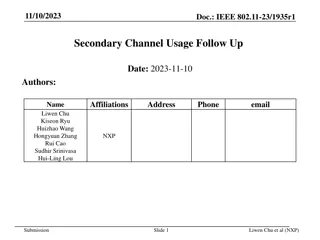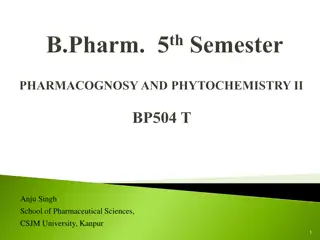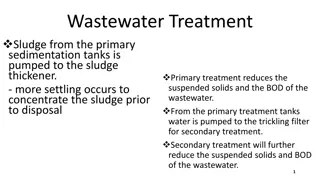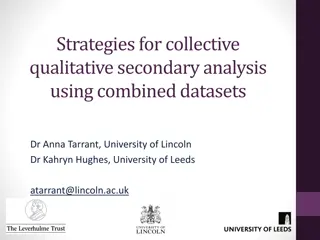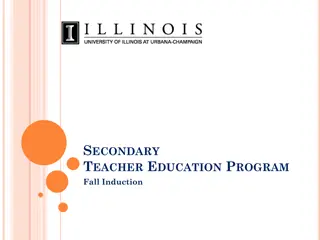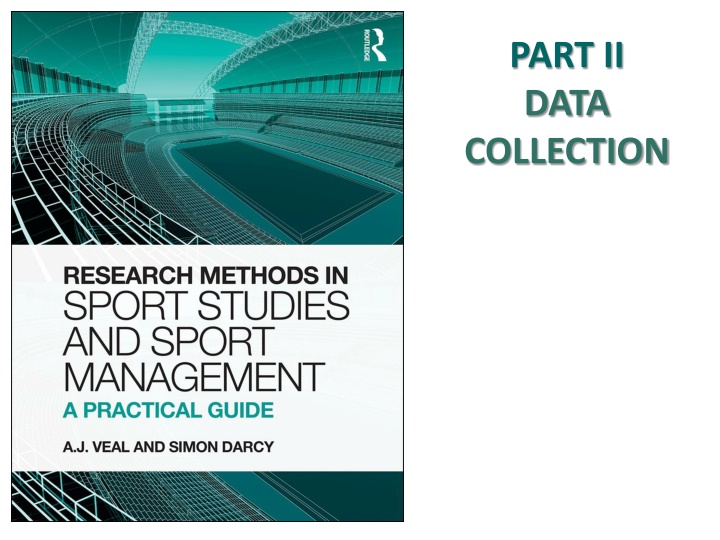
Sport Data Collection and Analysis Methods
Explore the process of data collection, analysis, and communication of results in sport studies using secondary data sources. Learn about various types of individual engagement with sports, measurement methods, and typologies outlined by Veal & Darcy in their practical guide. Discover insights on measuring sport participation rates, number of participants, and volume of engagement.
Uploaded on | 1 Views
Download Presentation

Please find below an Image/Link to download the presentation.
The content on the website is provided AS IS for your information and personal use only. It may not be sold, licensed, or shared on other websites without obtaining consent from the author. If you encounter any issues during the download, it is possible that the publisher has removed the file from their server.
You are allowed to download the files provided on this website for personal or commercial use, subject to the condition that they are used lawfully. All files are the property of their respective owners.
The content on the website is provided AS IS for your information and personal use only. It may not be sold, licensed, or shared on other websites without obtaining consent from the author.
E N D
Presentation Transcript
PART II DATA COLLECTION
Structure PART II DATA COLLECTION PART III ANALYSIS PART I PREPARATION 7. Secondary data 14. Secondary 1. Introduction 8. Observation 2. Approaches 9. Qualitative 15. Qualitative 3. Starting out 10. Questionnaires 16. Survey data 4. Research ethics 11. Experimental 17. Statistical 5. Range of methods 12. Case studies PART IV COMMUICATE RESULTS 6. Reviewing lit. 13. Sampling 18. Research report
Chapter 7: Secondary data sources
Preliminary issue: measuring sport activity A. J. Veal & S. Darcy (2014) Research Methods for Sport Studies and Sport Management: A practical guide. London: Routledge
Typology of individual engagement with sport (Fig. 7.1) Action/ consumption Type of engagement Production/ active 1. Professional 2. Active leisure 3. Volunteer Consumption/ receptive 1. Spectator/ fan/supporter 2. Consumer/ fan A. J. Veal & S. Darcy (2014) Research Methods for Sport Studies and Sport Management: A practical guide. London: Routledge
Typology of individual engagement with sport (contd) Action/ consumption Type of engagement Mode of engagement Production/ active 1. Professional Full-time Part-time 2. Active leisure Amateur Hobbyist 3. Volunteer Volunteer Consumption/ receptive 1. Spectator/ fan/supporter Committed live Occasional live 2. Consumer/ fan Mediated A. J. Veal & S. Darcy (2014) Research Methods for Sport Studies and Sport Management: A practical guide. London: Routledge
Typology of individual engagement with sport (contd) Action/ consumption Type of engagement Mode of engagement Examples F/T professional athlete, official, manager P/T professional athlete Production/ active 1. Professional Full-time Part-time Amateur athlete (org./comp/club-based) Casual participant 2. Active leisure Amateur Hobbyist Volunteer/unpaid coach, official, marshal 3. Volunteer Volunteer Reg. live spectator/supporter club member Occasional live spectator Consumption/ receptive 1. Spectator/ fan/supporter Committed live Occasional live Watching on TV/DVD, listen to radio, on- line, reading sport print-media 2. Consumer/ fan Mediated A. J. Veal & S. Darcy (2014) Research Methods for Sport Studies and Sport Management: A practical guide. London: Routledge
Measuring Sport (Fig. 7.2) Measure Definition Relationships A. Participation rate B. Number of participants C. Volume of activity (visits) The proportion of a defined population which engages in an activity in a given period of time Number of people in a defined community who engage in an activity in a given period of time. The number of visits made to a defined geo- graphical area, or games played in an activity by members of a defined community in a specified time period The amount of leisure time available to the individual in a defined community, over a specified period - or time spent on specific activity A x pop'n. or C frequency of visit B x visits/games per time period D. Time C x time per visit E. Expenditure Amount of money spent per individual or by a defined community on leisure or particular leisure goods or services over a specified time period. Energy expenditure during exercise or max. rate at which body can transport/use oxygen (VO2max) C x spend per visit E. Intensity F. Employment Engagement in sporting activity involving payment
Measurement: Sport examples (Fig. 7.2 contd) Measure A. Participation rate 6 per cent of the adult population of community X go swimming at least once a week. B. Number of participants C. Volume of activity (visits) community X (one million by local residents) in a year. D. Time Adults spend an average of 15 minutes per day engaging in exercise . E. Expenditure Consumer expenditure on leisure in Britain is over 50 billion a year F. Intensity Elite male runners have VO2 max of more than 80 millilitres per kilogram of bodyweight per minute G. Employment It is estimated that 4.5 million people are employed in sport in Europe. Example 20,000 people in community X swim at least once a week. There are 1.2 million visits to swimming pools in A. J. Veal & S. Darcy (2014) Research Methods for Sport Studies and Sport Management: A practical guide. London: Routledge
Counting heads: sport (Fig. 7.3) Administrative facility based 1. Individual ticket sales 2. Bookings data 3. Season ticket/annual pass sales 4. Membership records/surveys 5. Parking ticket sales data Questionnaire-based surveys (see Ch. 10) 6. Resident survey 7. Tourist survey 8. On-site visitor interview surveys A. J. Veal & S. Darcy (2014) Research Methods for Sport Studies and Sport Management: A practical guide. London: Routledge
Counting heads: sport (Fig. 7.3) contd On-site visitor counts (see Ch.8) Automatic 9 Automatic vehicle counters 10 Automatic pedestrian counters 11 Video-time-lapse cameras/aerial photography Visual/manual 12 Entrance or exit flows 13 Spot counts of numbers present at various times A. J. Veal & S. Darcy (2014) Research Methods for Sport Studies and Sport Management: A practical guide. London: Routledge
Primary vs Secondary data Primary data: new data specifically collected in the current project researcher is primary user Secondary data data already exists, collected for some other purpose researcher is secondary user A. J. Veal & S. Darcy (2014) Research Methods for Sport Studies and Sport Management: A practical guide. London: Routledge
Advantages/disadvantages of using secondary data (Fig. 7.4) Advantages Timing data may be instantly available. Cost cost of collecting new data avoided. Experience the 'trial and error' experience of those who collected the original data can be exploited. Scale possibly larger samples than would otherwise be possible. Serendipity inductive process of data analysis may yield serendipitous findings, which may not have arisen otherwise. A. J. Veal & S. Darcy (2014) Research Methods for Sport Studies and Sport Management: A practical guide. London: Routledge
Disadvantages Design secondary data has been designed for another purpose: may not be ideal. Analysis limitations opportunities for analysis/manipulation of the data for the current project may be limited. A. J. Veal & S. Darcy (2014) Research Methods for Sport Studies and Sport Management: A practical guide. London: Routledge
Types of secondary data (Fig. 7.5) Administrative/management data National sport participation surveys Economic surveys Elite sport performance data The census of population Documentary sources Opportunism A. J. Veal & S. Darcy (2014) Research Methods for Sport Studies and Sport Management: A practical guide. London: Routledge
Administrative/management data Management data (Fig. 7.6) Visitor numbers (in various categories) Visitor expenditure/income (in various categories) Bookings and facility utilisation Customer enquiries Membership numbers and details Customer complaints Results of visitor/customer surveys Expenditure of the organisation (under various headings) Staff turnover/absenteeism, etc. A. J. Veal & S. Darcy (2014) Research Methods for Sport Studies and Sport Management: A practical guide. London: Routledge
National sport participation surveys: International publications (Fig. 7.8) Trends in Sports: a Multinational Perspective. Kamphorst & Roberts (1989) Worldwide Experiences and Trends in Sport for All. DaCosta & Miragaya (2002) Free Time and Leisure Participation: International Perspectives. Cushman, Veal & Zuzanek (2006) Participation in Sport: International Policy Perspectives. Nicholson, Howe & Houlihan (2011) The Citizens of the European Union and Sport: Special Eurobarometer Reports. European Commission (nd) A. J. Veal & S. Darcy (2014) Research Methods for Sport Studies and Sport Management: A practical guide. London: Routledge
National sport participation surveys: UK Active People survey Conducted by: Sport England Sample size: 190,000 Dates: Annual since 2007 Age-range: persons aged 16 and over Participation data items Sport and recreational physical activity Walking at least 30 mins (freq. in last 4 weeks, pace) Cycling as for walking Other sport/recreation/physical activity as for walking Sports club membership Competitive sports participation Instruction/coaching in sport Overall satisfaction with sports provision Likelihood to do more sport: name one activity Change in participation in last year: reason A. J. Veal & S. Darcy (2014) Research Methods for Sport Studies and Sport Management: A practical guide. London: Routledge
National sport participation surveys: Active People Survey contd Socio-demographic data items Gender Age Ethnic group Age completed full-time education Highest qualification Accommodation type No. of children in household Car/van availability Disability Current work status Socio-economic status (10 questions) Main income-earner occupation Postcode A. J. Veal & S. Darcy (2014) Research Methods for Sport Studies and Sport Management: A practical guide. London: Routledge
National sport participation surveys: Australia Exercise Recreation and Sport Survey (ERASS) Conducted by: Standing Committee on Recreation and Sport (SCORS) Dates: Annual since 2001-2010 Sample size: 13,000 Age-range: persons aged 16 and over Participation data items Individual sport/physical activities participated in at least once in previous year. For the above: no. of times; whether organised by club etc. or informal Activities participated in during previous 2 weeks: frequency, time spent. Socio-demographic data items Gender, Age, Marital status, Parental status, no. children Highest education qualification, Employment status, Hours worked Aboriginal , Language spoken at home Postcode A. J. Veal & S. Darcy (2014) Research Methods for Sport Studies and Sport Management: A practical guide. London: Routledge
National sport participation surveys: Australia contd Since 2010: Australian Bureau of Statistics Participation in Sport and Physical Recreation (Cat. No. 4177.0) 2009-10 2011-12 (Spreadsheet tables only) A. J. Veal & S. Darcy (2014) Research Methods for Sport Studies and Sport Management: A practical guide. London: Routledge
National surveys: issues Validity and reliability dependent on self-report Sample size typically large Main question: reference period (see next slide) Age range most exclude children Social characteristics opportunities for detailed study/forecasting A. J. Veal & S. Darcy (2014) Research Methods for Sport Studies and Sport Management: A practical guide. London: Routledge
National surveys: effect of reference period differences Table 7.1 England 2002 Participated at least once in last year % of persons aged 16 and over 45.9 34.8 19.1 9.1 1.0 12.1 6.4 7.0 3.8 2.4 3.5 .3.8 = most common measure Sports* Walking Swimming Cycling Football Athletics** Golf Badminton Tennis Squash Cricket Equestrian Bowls A. J. Veal & S. Darcy (2014) Research Methods for Sport Studies and Sport Management: A practical guide. London: Routledge
National surveys: effect of reference period differences Table 7.1 England 2002 Participated at least once in last year % of persons aged 16 and over 45.9 34.8 19.1 9.1 1.0 12.1 6.4 7.0 3.8 2.4 3.5 .3.8 Participated at least once in last 4 weeks Sports* Walking Swimming Cycling Football Athletics** Golf Badminton Tennis Squash Cricket Equestrian Bowls 34.9 13.8 9.0 4.9 0.3 4.8 1.8 1.9 1.3 0.6 1.9 1.3 A. J. Veal & S. Darcy (2014) Research Methods for Sport Studies and Sport Management: A practical guide. London: Routledge
National surveys: effect of reference period differences Table 7.1 England 2008-09 Participated at least once in last month % of persons aged 16 and over na 13.2 9.3 7.4 6.4 3.5 2.4 2.4 1.2 1.0 1.0 1.0 P Sports* Walking Swimming Cycling Football Athletics** Golf Badminton Tennis Squash Cricket Equestrian Bowls A. J. Veal & S. Darcy (2014) Research Methods for Sport Studies and Sport Management: A practical guide. London: Routledge
National surveys: effect of reference period differences Table 7.1 England 2008-09 Participated at least once in last month % of persons aged 16 and over na 13.2 9.3 7.4 6.4 3.5 2.4 2.4 1.2 1.0 1.0 1.0 Participated for at least 30 mins in last week Sports* Walking Swimming Cycling Football Athletics** Golf Badminton Tennis Squash Cricket Equestrian Bowls na 7.6 4.5 5.1 4.2 2.1 1.3 1.3 0.7 0.5 0.8 0.6 A. J. Veal & S. Darcy (2014) Research Methods for Sport Studies and Sport Management: A practical guide. London: Routledge
Time-use surveys Survey respondents keep a diary of activities for 1-2 days Britain, 2005 Australia, 2006 Hrs per week: average for all persons aged 15+ 57.3 18.3 1.2 23.4 19.8 14.7 22.3 12.3 168.0 Sleep TV/video/radio/music Sport/physical recreation Other leisure Paid work Personal care Domestic work/childcare Travel and other Total 59.6 16.3 2.2 18.2 24.1 17.1 22.7 10.0 168.0 A. J. Veal & S. Darcy (2014) Research Methods for Sport Studies and Sport Management: A practical guide. London: Routledge
Elite sport performance Measures of national performance in multi-sport international sport events Gold medals won Total medals won (gold, silver, bronze) Medal points (e.g.: gold=3, silver =2, bronze =1) No. of athletes qualifying to take part No. of athletes in finals No. of athletes posting: season's best, personal best performance breaking records Market share: country's % share of all medals or points awarded Cost (government expenditure) per medal Each of the above related to national population and/or income See Shibli & Bingham (2005) + Ch. 14 Case Study 14.5 A. J. Veal & S. Darcy (2014) Research Methods for Sport Studies and Sport Management: A practical guide. London: Routledge
Economic data Household expenditure survey data A. J. Veal & S. Darcy (2014) Research Methods for Sport Studies and Sport Management: A practical guide. London: Routledge
Population census Count of every person present in a country on a specified night Typically conducted every 10 years (UK) or 5 years (Australia) A. J. Veal & S. Darcy (2014) Research Methods for Sport Studies and Sport Management: A practical guide. London: Routledge
Census: Data available at various levels (Fig. 7.11) Britain National Regions Counties Local government areas Parliamentary constituencies Enumeration districts (EDs) Australia National State Postal codes Local government areas State and federal Parliament electorates Collection districts (CDs) A. J. Veal & S. Darcy (2014) Research Methods for Sport Studies and Sport Management: A practical guide. London: Routledge
Census data: resident population (Fig. 7.12) Number of males/females Number/proportion in 5-yr age-groups (single yrs for < 20s) Numbers of people: with different religions by country of birth speaking different languages by country of birth of parents Numbers of families/households: of different sizes with different numbers of dependent children which are single parent families with various numbers of vehicles Numbers of people: who left school at various ages with different educational/technical qualifications different occupational groups by working hours A. J. Veal & S. Darcy (2014) Research Methods for Sport Studies and Sport Management: A practical guide. London: Routledge
Uses of the census (see Ch. 14) planning sport facilities conducting feasibility studies area management/marketing facility performance evaluation market segmentation A. J. Veal & S. Darcy (2014) Research Methods for Sport Studies and Sport Management: A practical guide. London: Routledge
Documentary sources (Fig. 7.12) Minutes of committee/council/board meetings Correspondence of an organisation or an individual Archives (may include both of the above + other papers) Popular literature, such as novels, magazines Newspapers, particularly coverage of specific topics and/or particular aspects, such as editorials, advertising or correspondence columns Brochures and advertising material Diaries A. J. Veal & S. Darcy (2014) Research Methods for Sport Studies and Sport Management: A practical guide. London: Routledge




